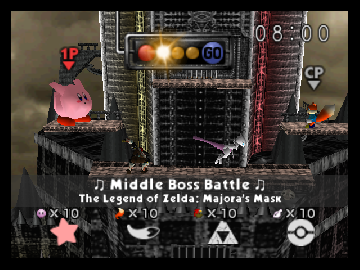Kid Dracula (USA, Europe)
Juega Kid Dracula (USA, Europe) en línea en tu navegador. Sin necesidad de descargar.
Sobre Kid Dracula (USA, Europe) :
.png)
Kid Dracula: The Playful Gothic Adventure
Step into the tiny cape of the vampire prince with Kid Dracula, a charming action platformer that reimagines the Castlevania universe through a whimsical, child-friendly lens. Players control the adorable diminutive version of the infamous count as he embarks on a quest to reclaim his castle and title from the mischievous demon Galamoth, who has taken advantage of Kid Dracula's century-long nap to seize control of the vampire realm. Throughout the adventure, Kid Dracula traverses diverse gothic environments from haunted castles and foggy graveyards to mechanical fortresses and surreal otherworldly domains, each filled with comical monsters and supernatural hazards that parody the more serious threats found in traditional Castlevania games. The distinctive visuals of Kid Dracula blend macabre elements with cartoonish charm, creating a unique aesthetic that manages to be both spooky and adorable as the vampire child confronts exaggerated versions of classic horror creatures including werewolves, mummies, and sea monsters. As players progress, Kid Dracula gains access to various supernatural abilities including transforming into a bat, shooting fireballs, and even summoning lightning, creating a progression system that consistently introduces new gameplay mechanics throughout the adventure. With its perfect balance of platforming challenge, light-hearted humor, and playful takes on vampire mythology, Kid Dracula delivers an engaging adventure that stands as both a delightful parody of classic horror games and a substantial gaming experience in its own right.
The Cultural Legacy of Kid Dracula
Originally released in Japan in 1990 as 'Akumajō Special: Boku Dracula-kun' for the Famicom before receiving a Game Boy sequel that eventually made its way to Western audiences, Kid Dracula represents an interesting chapter in Konami's experimentation with their established franchises. The game emerged during a period when developers began creating more accessible spin-offs of their mature titles, with Kid Dracula serving as a lighthearted counterpart to the more serious Castlevania series that would appeal to younger players while still containing enough challenge and depth to satisfy experienced gamers. As one of the earlier examples of a parody game that lovingly satirized its parent franchise, Kid Dracula helped establish a trend of self-referential humor that would become increasingly common in gaming. The title's antagonist Galamoth would later appear in conventional Castlevania games, creating an interesting connection where a character from the parody series crossed over into the main timeline. For many years, Kid Dracula remained a relatively obscure entry in Konami's catalog, particularly outside Japan, gaining reputation as a hidden gem among collectors of retro games. Recent inclusion in compilations like the Castlevania Anniversary Collection has introduced this charming title to new generations of players, cementing its place in gaming history not just as a Castlevania curiosity but as a quality platformer that successfully balanced accessibility, humor, and genuine gameplay challenge.
Mastering the Little Vampire's Powers
What Makes Kid Dracula a Fangtastic Experience
- Progressive ability system granting new vampire powers as you advance
- Transformation mechanics allowing Kid Dracula to become a bat for flight sequences
- Diverse gothic environments with playful horror-themed elements
- Comical boss battles against oversized monsters with distinctive attack patterns
- Mini-games between levels that offer additional challenges and rewards
- Humorous storyline that parodies vampire tropes and Castlevania conventions
- Distinctive visual style blending cute character designs with gothic elements rarely seen in retro games
Navigating the Supernatural World as Kid Dracula
Playing Kid Dracula involves mastering both platforming fundamentals and the young vampire's expanding arsenal of supernatural abilities. The core gameplay revolves around precise jumping, avoiding obstacles, and using Kid Dracula's fireball attack to defeat the various comedic monsters that populate each level. As players progress through Kid Dracula, new abilities are unlocked including a bat transformation that allows for limited flight, a shield spell for protection, and more powerful projectile attacks that can be fired in multiple directions. The game introduces these mechanics gradually, with each new area of Kid Dracula requiring strategic use of recently acquired powers to overcome increasingly complex environmental puzzles and enemy arrangements. Between main stages, Kid Dracula features mini-games that test different skills while providing opportunities to earn extra lives and power-ups. Like many beloved retro games of its era, Kid Dracula implements a lives system with limited continues, though the game's difficulty curve is more forgiving than its serious Castlevania counterparts, making it accessible while still providing substantial challenge in later levels. Enemy patterns in Kid Dracula require observation and timing, with boss battles serving as skill checks that test mastery of movement and attack mechanics against larger foes with multiple attack phases and vulnerabilities.
.png)
.png)
.png)
.png)
 (En,Ja).png)

.png)
.png)
.png)
.png)
 (En,Fr,De,Es,It,Nl,Sv).png)
.png)